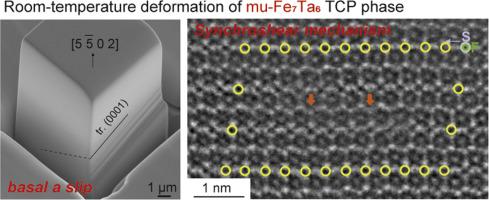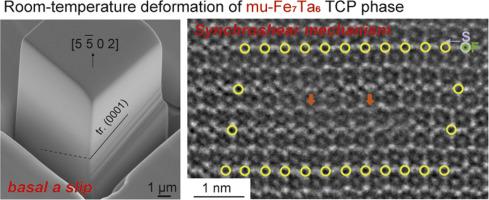采用微柱压缩法研究了mu相化合物Fe7Ta6单晶的缺陷结构和室温变形
IF 9.3
1区 材料科学
Q1 MATERIALS SCIENCE, MULTIDISCIPLINARY
引用次数: 0
摘要
采用微柱压缩法研究了mu相化合物Fe7Ta6的单晶在室温下的变形行为与晶体取向和试样尺寸的关系。为了避免将生长缺陷与变形引起的缺陷混淆,还对生长缺陷进行了研究。(0001)<21 - 1 - 0>(基a)滑移被确定为在室温下工作的优势滑移系统。基底滑移的CRSS高达1.24 GPa。对位错核心的直接观察表明,mu相的Fe7Ta6的基本滑移仅在MgCu2 (Laves-phase)块层的三层内通过同步剪切机制发生,因此一种形式的MgCu2块层通过领先的同步-肖克利部分位错转变为另一种形式(双相关)。除了在[0001]堆叠顺序中加入不同形式的MgCu2块层时形成的(0001)基面上的平面缺陷(堆叠缺陷和双胞胎)以及连续插入或删除MgCu2或Zr4Al3类型的块层时形成的平面缺陷外,还可以识别{11 - 02}和{11 - 01}锥面上的平面缺陷。这些{11的02的}和{11的01的}的金字塔状的故障被发现,第一次被引入,以容纳晶格不相容由(0001)基面上引入一个互生的故障。本文章由计算机程序翻译,如有差异,请以英文原文为准。


Defect structures and room-temperature deformation of single crystals of the mu-phase compound Fe7Ta6 investigated by micropillar compression
The deformation behavior of single crystals of the mu-phase compound Fe7Ta6 has been investigated by micropillar compression at room temperature as a function of crystal orientation and specimen size. Grown-in planar defects have also been investigated to avoid the confusion of grown-in defects and those introduced by deformation. (0001)<20> (basal a) slip is identified to be the dominant slip system operative at room temperature. The CRSS for basal a slip is as high as 1.24 GPa. Direct observation of the dislocation core indicates that basal a slip in Fe7Ta6 of the mu-phase occurs by a synchroshear mechanism exclusively within the triple layers of the MgCu2 (Laves-phase) block layer, so that one form of the MgCu2 block layer is transformed into another (twin-related) by the passage of the leading synchro-Shockley partial dislocation. In addition to planar faults on the (0001) basal plane formed when a different form of the MgCu2 block layer is incorporated in the [0001] stacking sequence (stacking faults and twins) and when a block layer either of the MgCu2 or Zr4Al3 type is inserted consecutively or deleted, planar faults on {102} and {10} pyramidal planes are identified. These {102} and {10} pyramidal faults are found, for the first time, to be introduced to accommodate lattice incompatibility generated by the introduction of an intergrowth fault on the (0001) basal plane.
求助全文
通过发布文献求助,成功后即可免费获取论文全文。
去求助
来源期刊

Acta Materialia
工程技术-材料科学:综合
CiteScore
16.10
自引率
8.50%
发文量
801
审稿时长
53 days
期刊介绍:
Acta Materialia serves as a platform for publishing full-length, original papers and commissioned overviews that contribute to a profound understanding of the correlation between the processing, structure, and properties of inorganic materials. The journal seeks papers with high impact potential or those that significantly propel the field forward. The scope includes the atomic and molecular arrangements, chemical and electronic structures, and microstructure of materials, focusing on their mechanical or functional behavior across all length scales, including nanostructures.
 求助内容:
求助内容: 应助结果提醒方式:
应助结果提醒方式:


